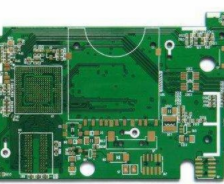The PCB circuit diagram template is made on the film, and the exposure machine, developing machine, and etching machine used have been fully localized. The core technology of PCB lies in copper clad laminate technology, and domestic copper clad laminate technology can already be comparable to foreign ones.
The general production process of copper clad laminate:
Prepare a solution of resin, filler, and organic solvent (mainly acetone and methyl ethyl ketone) - soak the glass fiber cloth with the resin solution, then dry, the dried glass fiber cloth, the industry is called PP sheet - according to the production The thickness of the copper clad laminate, stack the PP sheets, put the copper foil on the bottom and top - align them and put them in a constant temperature and pressure press for pressing and curing - take out after the preset curing time is reached
The characteristics of the copper clad laminate:
Good temperature resistance, that is to say, the glass transition temperature Tg should be high, which is not easy to soften.
The peel strength of the copper foil on the board should be high, and it is not easy to tear.
The flame resistance, breakdown voltage should be high, and the dielectric constant should be good.
Core Technology of Copper Clad Laminate

One is the resin, filler, and curing agent used. Resin is the key. The second is the laminated combination technology, which can be understood as: there is also a copper clad laminate in the copper clad laminate.
The most widely used resin in the industry is bisphenol A epoxy resin. If the temperature resistance of the copper clad laminate is required, that is, if the Tg glass transition temperature is high, phenolic resin or modified bisphenol A can be used. Epoxy resin.
At present, bisphenol A epoxy resin is also produced by corresponding PCB manufacturers in China, and its performance is equivalent to that of imported products.
Although the gap between domestic copper clad laminate technology and foreign technology is narrow, in some high-end fields, European, American and Japanese technologies are still the mainstay. Domestic resin manufacturers mainly produce bisphenol A epoxy resin, and there is still a gap between resin technology with special properties and Europe and the United States.
The main resin of copper clad laminates used in general electronic products is bisphenol A epoxy resin. This type of resin contains halogen and has flame resistance. The majority of domestic manufacturers of such copper clad laminates are currently using polytetrafluoroethylene resin.
filler
The fillers used in the copper clad laminate formula are mainly silica SiO2 and aluminum oxide Al2O3. At present, there is basically no difference between these fillers from domestic manufacturers and imported ones.
Hardener
The curing agent of bisphenol A epoxy resin is self-produced and self-sufficient in China. For special resins, such as phenolic resins, the curing agents used are mainly from Europe, America and Japan.
Laminated combination technology
PCB rigid board, cannot be folded. The foldable circuit board is called FPC.
In most cases, the PCB is used as the main board, and the chip is also soldered on the PCB. FPC flexible boards are mainly used for connecting parts such as flat cables of electronic products. Compared with PCBs, they are lighter in weight and smaller in size, and can be bent and folded.
Although some special types of resins and curing agents have to rely on imports, but the copper clad laminate composite technology.